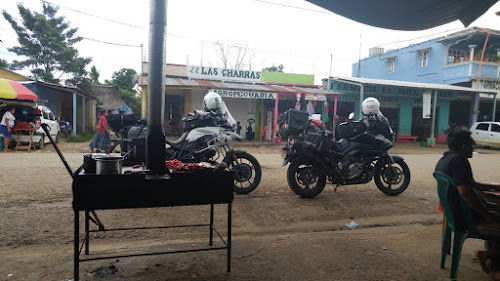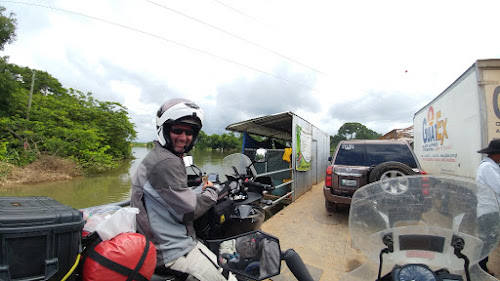Many people know Guatemala is a coffee producing country, but there is something special about really being able to see where the stuff you love comes from. After Chichicastenango, we headed to Antigua. It had sort of been on our list of places to go, but we could skip it if we were pressed for time. One of the big draws for us was La Azotea Coffee Plantation and museums.
A few days prior to our arriving in Chichi, the GPS gave up the ghost. Much time was spent pulling it apart, buying a multimeter to see where and how power was or was not getting to it, and pronouncing it officially dead. While in Chichi, with good internet, Josh got ahold of a rider and bought a new GPS of the same model. It was shipped to our neighbor's house in Denver, and they will be bringing it on their trip to Costa Rica, where we will meet them and pick it up.
So, all of that is to explain that we realized we had some extra days allotted to us. We didn't have to hurry through, so we headed to Antigua, and the Hostel Antigueno. Another stellar find, this hostel is run by Christian--an Antigueno who spent time growing up in California--and his wife, and we were allowed to camp in the hostel's lovely garden. We got there early in the day, got the tent set up, and headed off to the coffee plantation.
 |
| Josh practicing in the Mayan Museum of music. That museum and tour were a really lovely surprise. |
We paid our entrance/tour fee, and walked in thinking we were going to wind up on a tour with a bus load of French tourists. As it turned out, they were just finishing their tour, and as we began ours, we were the only ones. The tour started in the museum of music--what, I thought we were here for coffee--with a lovely young Guatemalan girl who took us through the history of music, dance, celebration, and clothing of the Mayans of Guatemala.
 |
| Setup for a traditional Mayan market, which we had just gotten to see in Chichi. |
 |
| This is a typical Mayan wedding. Women wear traditional Mayan clothing with a colonial Spanish veil. |
At the end of that part of the tour, I went to ask her about what brides wear in Guatemala, and what the wedding ceremonies are like. As we were talking and she found out I was riding a motorcycle to Argentina, she got very excited, and said that was a dream of hers. She rides a motorcycle too! It was fun to talk to her about the gender gap in moto riding in Guatemala and the U.S., and fun to hear about her love of travel. I'm telling you, I have had the most fun in the most unexpected of places on this trip!
 |
| This girl right here! Maria Jose was so much fun to talk with, and maybe one day we'll get to ride together! |
As soon as we were done chatting, Josh and I had to run back to the sampling room to start the coffee plantation portion of the tour. I learned A LOT about coffe growing and production, things I never knew about. One of the most interesting things I learned was that due to lack of money in Guatemala and advertising, Colombia took over the market as having the best coffee, because they had the dude with the burro in commercials. Remember in the 1980s, when one coffee company would advertise with Juan Valdez and his burro--100% Colombian coffee?
 |
| As the saying goes: Coffee should be black as night, strong as passion, sweet as love, and hot as hell. Word. |
Well, it's not anymore. Those companies came to realize Guatemalan coffee was just as good (if not better, according to our perhaps heavily biased tour guide) and far cheaper to import than Colombian coffee. So, the importers import a mix, and now sell it as 100% shade-grown Arabica. (Which it is, though it's often implied it is also Colombian...)
After learning about the ins and outs of coffee production, we got to take a walk through the plantation. It was lush and beautiful, the coffee shaded by banana palms (which are making me banana-obsessed) and Ceiba trees. There was a ton of fruit on the small trees, and in a few spots they were turning red, signaling harvest time.
 |
| Coffee cherries getting ready to harvest. |
I've always had an appreciation for coffee--like a large number of people I know--but like the chocolate, I enjoyed really getting to know where it comes from, who it affects and how it affects them, and where my money actually goes each time I buy or make a cup. Wait, who am I kidding? I don't make coffee--that's Josh's job....
 |
| Little ceramic tiles are set into the curb to let you know parking is reserved for motos! Love. This. Town. |
 |
| One of these (giant) things is not like the others... |
We got back to the center of town in time to drop the bike at motorbike-only parking--most blocks have curbs painted in white for motorbike parking, and a little ceramic tile with a pic of a moto on it--and head to the Chocolate Museum. Less of a museum and more of a business, it was none-the-less a great stop. We did get to learn about chocolate production on a larger level, and try everything they had in the store. I would up buying chocolate tea, which is the toasted husks of the cacao bean left over when the bean is removed for production. It is delicious, and according to the store, has many health benefits. I suppose the main one is that if I have a cup of that tea, I'm not drinking a beer...? Whatever. It tastes really good.
 |
| Antigua's arch in the twilight. The city was really lovely, and had a magical feel to it at this time of night. |
 |
| Yes, that is a 30' light-up rosary hanging from the town's cathedral in Antigua. |
We wandered the streets of Antigua--which is a really beautiful city with really heinous stone streets if you're riding a motorbike--had some dinner from street vendors in the plaza in front of the cathedral, and headed back to the hostel for a relaxing evening of game-playing.
 |
| Chutes and Ladders in Guatemala--where the "chutes" are snakes biting children. This is THE WORST version of this game ever! |
The next morning, breakfast was included, and we sat at a table with a few other travelers sharing stories. Three of them were traveling next to Lanquin, and we found out that the day we had planned to go to Semuc Champey, the falls and all tours had been shut down for a time. Well, there you have it.
We left the hostel after reading border posts for the Honduran border crossing, and headed to an Office Depot to make copies we would need. Yep, Guatemala had Office Depots. Now you know.
 |
| Waiting in line, prior to knowing there was a special place for motos. A really nice local woman who was selling drinks or fruit to those waiting told us we should go to the front. |
We spent that night about an hour from the border at a hotel/camp area called Las Laureles, and rode on to the Honduran border the next morning.
By all accounts, it would be a quick, easy border crossing, and for the most part it was. One mistake, we ended up there ready to do the last part--customs for the bikes into Nicaragua--at 12. So...we had to wait until 1, because they are the only office there where EVERYONE in the office takes lunch at the same time. Ok, note to self. Don't cross borders at lunch...
When we were finally done, we rode into Honduras (country number 3) and within 20 minutes or so, were in Copan Ruinas, the small city next to the Copan Ruins, the last of the Mayan ruins we would be visiting.














































